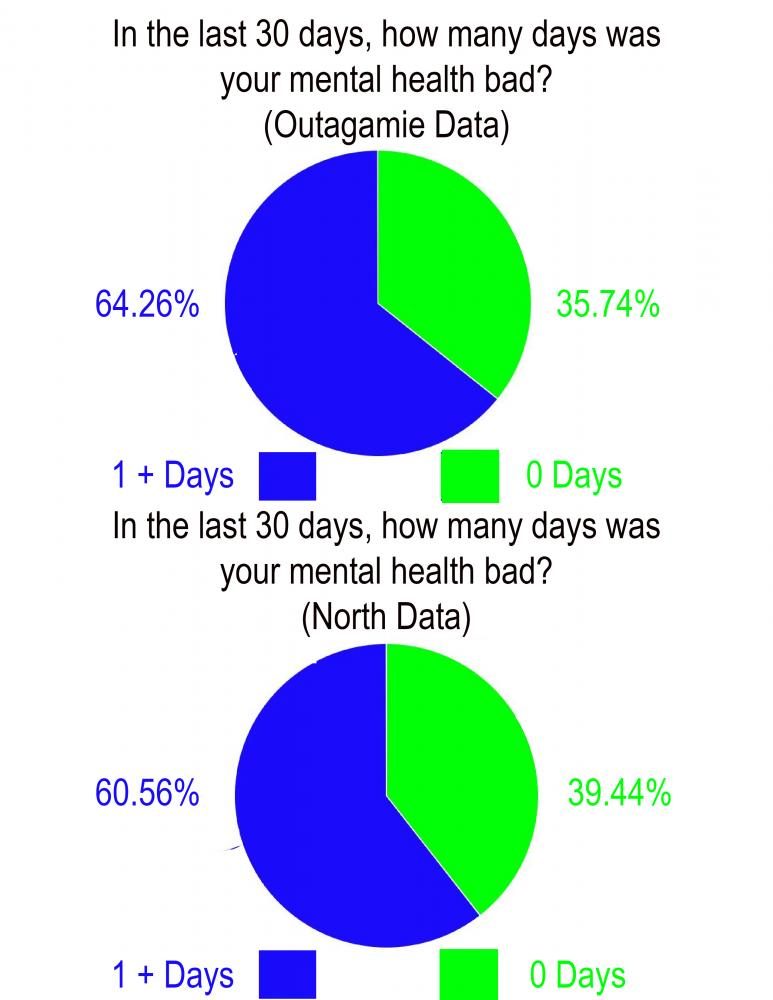North putting mental health front and center
The YRBS is an anonymous survey administered to North freshman and juniors. Of the total 732 students surveyed in the fall of 2015, 401 were freshman and 331 were juniors.
June 1, 2017
“The common thing to hear is ‘it gets better.’ Don’t get me wrong, it does, but I think a better thing to say is ‘it’s all worth it.’” These words are from Sam Stratton, an Appleton North junior who has dealt with mental illness as early as the 4th grade.
The month of May was Mental Health Month, and helped draw attention to an issue that affects everyone, students at North being no exception.
According to results from the 2015-2016 Youth Risk Behavioral Survey question, which asked “during the past 30 days, how many days was your mental health not good?”, 60.5 percent of surveyed North students reported one or more days, compared to Outagamie County results of 64.2 percent. With more than half of North’s surveyed students reporting troubles with mental health on one or more days in a thirty day period, North has continued to emphasize awareness and resources.
“I don’t know if we can ever have enough [resources]. I do think that Appleton North is making a cognitive effort to raise awareness about mental health,” said Mr. Eric Eastman, Psychology teacher and leader of Psych Club. “When you look at stats saying 20-25 percent of people in the U.S. suffer from depression, people still try to fight alone. They thinking they’re alone. Peer-led efforts work better, so students make other students aware of resources and peers that can help them and get them the help they need.”
Though many fight mental illnesses like depression alone, some students are willing to talk about their experiences with mental illness.
“If I had a message for people with mental illnesses it would be: don’t be afraid of admitting that there’s something different about you. Just because there’s something different about you doesn’t make you any less capable,” North Senior Yasmeen Ashour said. Diagnosed with anxiety at a young age, Ashour went to therapists and tried different medications to help her handle her anxiety.
However, these weren’t completely effective.
“Whenever I wasn’t occupied or anxious, I would notice how tired, sad, and exhausted I was.” This led to another diagnosis of chronic depression. “Anxiety and depression are like two buttons. When one is pushed down, the other is pushed up. It makes it really hard to find medication for one that doesn’t set the other off.” Ashour eventually went through five different medications over the following years, looking to balance anxiety and depression.
Ashour explains she is in a much better place now. “I can still have bad days, but the people I surround myself with are really understanding and positive. You just need to insert yourself in a positive environment.”
These experiences have made Ashour passionate about raising awareness about mental health.
“I see people struggle and I want to make it easier for them and have them understand all the stigmas around mental health. I want them to know they’re still capable people,” she said.
Stigmas play a large role in the fight against mental health issues. “Since there’s a stigma, people don’t want to say they have [a mental illness]. Since no one wants to talk about it, the stigma gets stronger,” Eastman explains.
This stigma led another student, Stratton, to believe what he was feeling when he was young was normal.
“I’d never learned it wasn’t normal. I thought everyone else had these feelings too.” After an increase in severity, Stratton finally decided to speak up and get help, going through nine different medications and eight different therapists, and at one point needing to go to a psychiatric hospital.
“Being there isn’t like any other experience in your life. You see these people who seem fine – they are amazing people – but you know they’re struggling too… It was a revelation for me. It was the first way it really occurred to me that I wasn’t the only one.”
After finally finding a therapist he clicked with and a medication that worked, Stratton was able to lead a positive and healthy life. “The first step is really letting someone know. The moment you share with someone else, it’s liberating.”
“I think that it’s unfortunate, but honestly not shocking,” Stratton said about the statistic that 19.4 percent of North students felt extended signs of depression, according to the YRBS survey. Additionally, Outagamie County YRSB results show 24 percent of surveyed students reported extended signs of depression.
“It’s always an eye opener to look at these statistics,” said North Social Worker Mrs. Sue Davis.
“It’s probably much higher than that,” Eastman said. “After a while, we don’t realize what it means to be healthy. The chaos doesn’t give us an opportunity to stop and take care of ourselves.” “[Stigmas] have created an environment where people are fearful of even saying suicide.”
One way North is approaching mental health is Sources of Strength, a suicide prevention project that uses peers to change culture to prevent things like suicide and bullying. With a goal to create a mindset of getting help, Sources of Strength approaches the topic with less focus on the risks and more on connections and resources.
North has integrated this new program with the wheel in the commons showing where students of North find their strength from, be it family, friends, healthy living, or many others.
“I think it will be incredibly beneficial. It will create a conversation and won’t hide the issue,” Eastman said.
While May is the official Mental Health Month, mental health is something that can affect people at any time, and one of the first steps to a healthy life is by telling someone.
“Life is really wonderful,” Stratton said, “and once you can live it without the weight of these negative feelings, it’s the most amazing feeling.”



